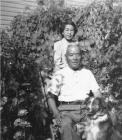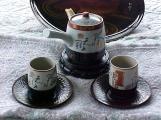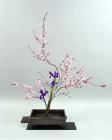1
We would like to let Aya Higashi introduce our project with a piece of her own prose.3
It is the gloaming. The light of day is fading, and the blue of night is deepening. The daytime sounds have not only diminished but have also been absorbed into the quiet of the approaching night. Twilight is long at the coast, at zero altitude…but eventually night will transcend. Quiet rules. Tranquillity. Serenity. Peace.As the blue of the dome overhead deepens, the evening star becomes visible and myriads of pinpoint lights join her. The sky is a canopy of twinkling, scintillating heavenly bodies.
Silhouetted against the fading light of day, two figures sit at a table in the windowed alcove., murmuring softly and sipping tea from antique cups, two hearts beating quietly in perfect harmony. There are no hurried motions, no raised voices. Peace and contentment are palpable. Light fades, but the figures continue to sit, murmur, sip, with long pauses in between.
5
(Kane and Kiyomatsu Atagi in their garden with their faithful collie, "Brook".:This picture of Aya's parents was taken after the war. All pictures from before the war were lost in the evacuation.)The figures are my parents, in their usual quiet evening time together, engaged in the ritual of the tea ceremony. It is their space in time, after the hustle and bustle of the day, and quiet and twilight have descended and enveloped the world.
At that juncture of my life (teenage), steeped in western culture and full of energy, I could neither understand nor begin to appreciate the practice of sitting quietly, seemingly doing nothing; seldom speaking, sipping minute quantities of a lukewarm beverage (not like the rich hot chocolate that I loved, nor the exhilarating bite of an ice-cold ginger ale). Somehow it all seemed to me so backward, primitive and useless. Why weren't they "doing" something: It seemed like such a waste of time.
7
(The Koto, a classical Japanese stringed instrument)In the quietude that pervades the room, shadows lengthen and the twittering of birds in the grove gradually subsides except for the occasional sleepy chirp emitted as the feathered denizens shift their positions on their perches among the foliage. Then quiet -- but not quite. The edges of our consciousness become aware of the soft strains of the Koto and shakuhachi, its beautiful familiar melody that pulls at the heartstrings almost bringing tears to the eye. Why so beautiful and yet so sad? The magic ends with the click-click-click of the gramophone needle indicating the end of the recording. Father gently reaches over and lifts its arm and turns the record over to play the reverse side. At other times he puts on a different record, one of several hundred in our collection.
Then silence. Silence? Not so. The air is full, replete with the tangible intangible-warmth, love, harmony, peace, contentment-all rolled into one. Its existence, its presence, requires no explanation. It simply is.
9
A long time later, a half-century later, I remember the tea ceremony, Chanoyu. It is my hope that I finally understand, admire, respect and envy. The western world now is familiar with the story, the practice of the tea ceremony. But do they, can they, experience the depth, the full dimension of the ritual? To my parents it was an integral part of their life. I truly believe that they survived the trials of the War Measures Act because of chanoyu and emerged unscathed, still trusting, internally strong but gentle.Mother taught me chanoyu only when I was ready, totally receptive. She neither pressured nor coerced. She knew that she had a daughter whose mind was of one culture, one world, and that she herself was of another-and that the two minds must connect on one plane of understanding and respect before it could be truly meaningful. Happily we succeeded. The experience each time touched me deeply and filled me with a beautiful calm and inexplicable joy.
11
In the alcove there was no clutter-only one treasured picture on one wall and an heirloom vase on a stand often holding one flower only or a pine sprig -- ikebana, a careful elegant art of flower arrangement. On the opposite wall there was a shelf on which rested father's shakuhachi on a stand and mother's koto under a silk dust-cover -- nothing garish, all simplicity and elegance in understatement. At times mother played the koto which father tuned for her, and at times father played the shakuhachi -- but somehow seldom together. Each enjoyed listening to the other. Father played the yokofue, too. His rendition of "Kojo no Tsuki" always brought tears to the surface. Mother's favourite was "Chidori no Kyoku". It struck a cord in my heart.13
My heart squeezes with pain and my eyes fill with unbidden and long-suppressed tears at the memory of my gentle loving parents. They bore their grief and pain in silence. They endured without complaint: stoic, accepting and trusting. Would in have hurt less had they wept noisily and openly or complained bitterly and loudly? But that was not their way. I wished I could protect them but then I was a victim myself at the time. Often I hugged my little mother and held her in my arms.During the war years and several years more, father was isolated from us, having been shipped to Crow's Nest to work on the railroad, while mother, in delicate health, together with a young son and an older daughter, was evacuated from Vancouver, first by rail to Slocan, then a few months later to Kaslo by bus. Neither knew the whereabouts or the situation of the other: censorship, no communication, myriads of restrictions, under guard at all times, all purported to be security risks. Uncertainty, not knowing , was the greatest torture.






